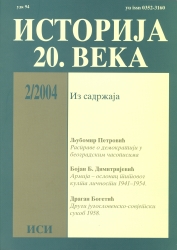Otpor srpskog građanstva „Novoj vlasti“ 1944–1950
The Serbian Citizens Resistance to “The New Authorities” 1944–1950
Author(s): Nataša MilićevićSubject(s): History
Published by: Institut za savremenu istoriju, Beograd
Keywords: Serbian citizens; chetniks’ groups; the new authorities;
Summary/Abstract: The composition analyzes the resistance as a hardly known phenomenon in the relation between Serbian citizens and ‘the new authorities’ within a few years’ period following the liberation of Serbia. It has been perceived that the smaller number of the Serbian citizens turned to resistance while the majority found themselves in the state of “expectation”. In addition to the declared anticommunists, all of those who had become the target for authorities’ revolutionary measures after the liberation, turned to resistance as well: the smaller number of city politicians, large and middle capitalists, especially members of their families, city youth, church, individuals who thought differently. Besides the leaders of resistance, some other characteristics of the Serbian citizens’ resistance have been analyzed too. In that sense, the following facts have also been emphasized: their tendency to align on war, even on its prolongation only in peacetime and with different means, interweaving and parallel activities of different shapes and forms of resistance (legal and illegal, passive and active, formal and organized, informal and spontaneous etc.). For instance, the legal resistance of civil politicians ran parallel with the process of illegal resistance of certain groups, either military factions, in the sense of Chetniks’ groups, either illegal city youth groups (organizations). It has been perceived that the resistance was encouraged with anticommunist and monarchist motives but the main initiators were authorities’ concrete deeds, especially for those city representatives who had not belonged to military formations in war. The most widespread and frequent forms of resistance have been especially observed. These include different ways of citizens refusing to reconcile with the existing state in social relations and state organization whether individually or in groups (expressing differences either in one’s appearance either in inherited spiritual needs, habits, refusing to go to work, going to church…), the importance of resistance through slogans as a specific form of stating opinions and attitudes of citizens, as well as the resistance organized by creating illegal anticommunist groups of city youth.
Journal: Istorija 20. veka
- Issue Year: 2004
- Issue No: 2
- Page Range: 63-97
- Page Count: 34
- Language: Serbian

